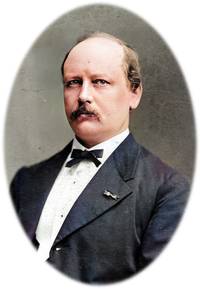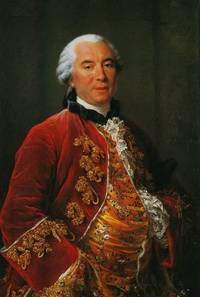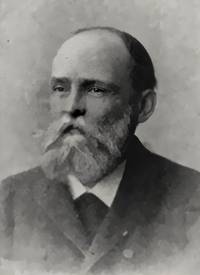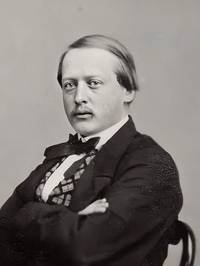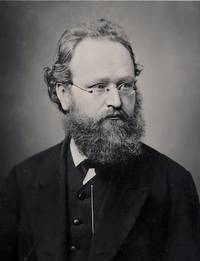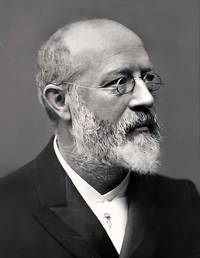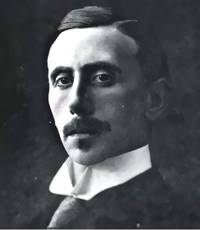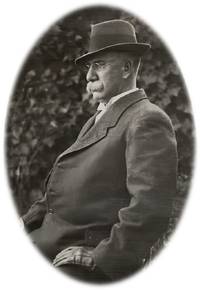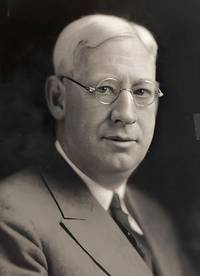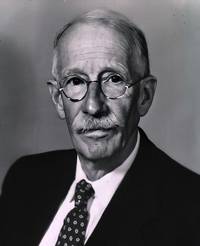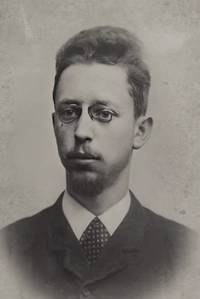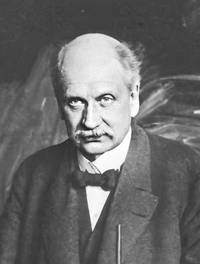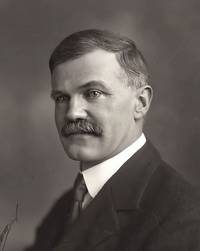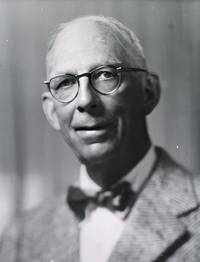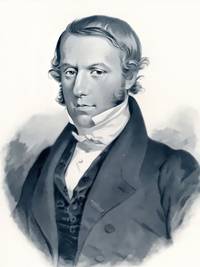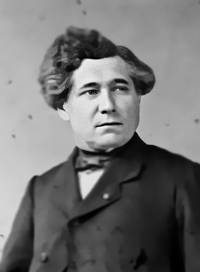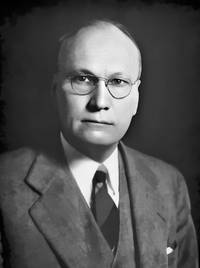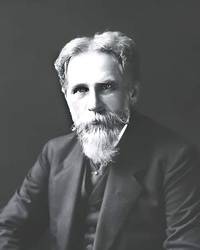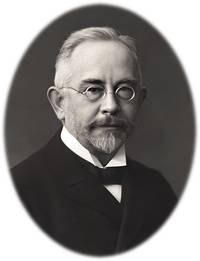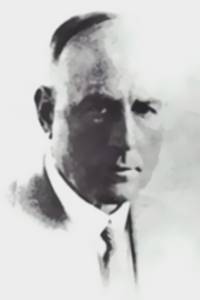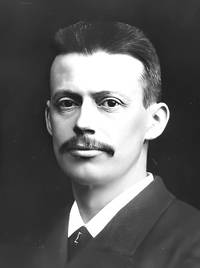A Swedish Scientist in Malling-Hansen’s Footsteps:
Gustav Nylin’s Doctoral Thesis.
By Jørgen Malling Christensen.
Karl Gustav Vilhelm Nylin, 1892-1961, was a Swedish physician and cardiologist of international reputation. He published a large number of works in the field of cardiology and also about the physiology of school-age children and young people. Nylin was a great admirer of Malling-Hansen’s research into seasonal periodicity, and for his doctoral thesis he chose to replicate Malling-Hansen’s research. Between 1922 and 1930 Nylin served as a school physician in the Stockholm suburb of Spånga, and in this capacity he had an outstanding opportunity to use data from the pupils of 10 schools for his research. During the period 1926-29 he regularly weighed and measured the height of 2416 pupils, of which 1903 participated in the complete series of measurements and, thus, were included in his vast statistical material.
Nylin’s research consciously and consistently followed in Malling-Hansen’s footsteps, using similar techniques and methods (apart from the frequency of measurements). However, Nylin broadened the perspective by including also measurements of the standard metabolism and oxygen capacity of the blood of his research subjects. This was a logical and intelligent extension of the Malling-Hansen research agenda; and moreover: it served to make his research more congruent and relevant in relation to other contemporary international research in the period after Malling-Hansen’s death and the time of Nylin’s thesis. Nylin found that during the maximum periods of growth in height, the basal metabolism was also at a maximum level.
In addition, Nylin also added the aspect of light radiation, testing its use and effects on part of his research subjects. In this, he may have been inspired or influenced by the example of Finsen, whose radiation institute in Copenhagen became world famous. Nylin found that the radiation had markedly strong stimulation effect on growth in terms of height, but that it decreased the growth in weight. Nylin points out that Finsen was the first researcher to show that hemoglobin levels (in adults) were also subject to seasonal variation. According to Nylin, in some of Finsen’s reports he discussed and made comparisons with those of Malling-Hansen.
Shortly after the successful defence of his thesis, Gustav Nylin visited the Royal Institute for the Deaf-Mute in October 1930 and gave a lecture entitled “The Present-day View of Malling-Hansen’s Research” (see “Lecture by Gustav Nylin in 1930”(in Swedish) on our website). In his lecture he praised Malling-Hansen for being “...the first researcher to define and practise a precise, scientifically accurate research methodology”.
Moreover, he claimed that Malling-Hansen was: “...the first to have analysed, with care and accuracy, the variations in height and length of school-age children, and to have found that their height decreases every day by 10 mm”.
He added that, apart from the French scientist Leclerc de Buffon (1707-1788) and Swedish physician Erik Vilhelm Wretlind (1838-1905), “...Malling-Hansen was the first to have found and documented a seasonal variation in terms of the growth of height and weight”.
These assessments come from a scientist of impeccable knowledge and reputation (Nylin); and what is remarkable is that Malling-Hansen was not even trained as a scientist, nor had he any medical or physiological training. In his ground-breaking research, Malling-Hansen was the first and the best of his period – and he was also a complete autodidact in this field!
Gustav Nylin has done us a great favour with his doctoral thesis: In his first chapter, “Historical Survey. Literature”, which follows this preface, he puts Malling-Hansen’s research into the perspective of similar and related research internationally back to the first contribution by Buffon in the mid 18th century and up to date (1929).
What emerges very clearly is that Malling-Hansen is part of a large array of researchers the vast majority of whom came after Malling-Hansen and to a large extent were inspired by him. His results were confirmed by Vahl, Camerer, Schmid-Monnard, Wiener, Carlier and Klaus Hansen in the 18th century, and by Porter, Schreiner, Schiøtz and Nylin during the period from 1900 until 1929.
According to chapter I of Nylin’s thesis, there were only three researchers before Malling-Hansen in this field: Buffon, Montbeillard and Andral, all of them French.
Contemporary with or following Malling-Hansen Nylin mentions 60 other researchers/scientists who have done research similar to or closely aligned with that of Malling-Hansen. These 60 scientists represent the following countries:Denmark: Vahl, Strandgaard, Lindhard, Johannsen, Finsen, Heerup
Norway: Hansen, Schiøtz, Schreiner (2 persons), Grundt, Kielland, Lunde, Bratt, Scheel, Føien
Sweden: Wretlind, Key, Sonden, Nylin
Finland: Rancken, Gripenberg, Grönberg, Tigerstedt, Olin
England: Kerr, Bleyer, Smith, Griffith
USA: Porter, Veeder, Rohlfing, Emerson, Burns, Benedict, Talbot, DuBois, McConnell, Fulton, Yagloglou, Kunde, Gustafsson
France: Carlier, Gavarett
Germany: von Krehl, Camerer, Monnard, Frank, Wimberger, Hartmann, Kestner, Peemöller, Gessler, Loewy, Jakowenko
Austria: Orel
Australia: Young.
Further details about the above scientists are in the footnotes added to Nylin’s text in his chapter I.
In summary: What we have in front of us is an entire new field of scientific research in physiology and metabolism, focused on periodicity. This research area started with Malling-Hansen and a few of his contemporaries. It has continued ever since, and Nylin has clarified the research field as it appears in the period from the 1880s until 1929.
It is my belief that this field of research has been ongoing and expanded ever since then and is still very much alive today. It is up to us to follow the trail and identify the post-1929 researchers, their work and their results.
It is also conceivable that the periodicity found by Malling-Hansen and many others is a universal phenomenon which influences not only humans but animals, plants and other living organisms. Malling-Hansen famously included the trees in his own backyard as his investigation subjects!
When he died in 1890 he left behind a question which remains to be answered:What is factor X? Is the mysterious life-force linked to the sun, to the moon or to some other factor or set of factors in the universe? The search is bound to continue! Malling-Hansen was a pioneer, and he set the standards of research by means of his rigorous methods and procedures. His research remains ground-breaking and relevant.
A Swedish biography about Gustav Nylin can be read in Svensk biografisk lexikon.
PERIODICAL VARIATIONS IN GROWTH, STANDARD METABOLISM AND OXYGEN CAPACITY OF THE BLOOD IN CHILDREN
AKADEMISK AVHANDLING
SOM MED TILLSTÅND AV KUNGL. KAROLINSKA INSTITUTETS LÄKARE-KOLLEGIUM FÖR ERNÅENDE AV MEDICINE DOKTORSGRAD OFFENT-LIGEN FÖRSVARAS Å PATOLOGISKA INSTITUTIONENS HÖRSALLÖRDAGEN DEN 18 JANUARI 1930 KL. 11 F.M.
av
G u s t a v N y l i n
Med.Lic.
STOCKHOLM 1929
ACTA MEDICA
SCANDINAVICA
SUPPLEMENTUM XXXI
P.A. NORSTEDT & SÖNER, STOCKHOLM 1929
KUNGL. BOKTRYCKERIET.
CHAPTER I.
Historical Survey. Literature.
An exogenous rhythm in man which is influenced by the seasons of the year was first described in the literature on the subject by BUFFON[1] in his “Histoire naturelle”. He describes how a certain MONTBEILLARD[2] followed his son’s growth from birth, in 1759, to the age of 17, by measuring him every six months, usually at the beginning of April and at the beginning of October. BUFFON gives the results of MONTBEILLARD’s observations in a detailed table, in which the boy’s height on the different occasions is indicated. The measurements were regularly carried out by the same person and the boy was barefooted. From MONTBEILLARD’s observations BUFFON arrived at the conclusion that before the age of 5 years increase in height takes place quite uniformly, but that the annual increase declines successively every year. On the other hand, after the age of five years a marked periodicity in height-increase makes its appearance and is considerably less during the six winter months than during the six summer months. During the last year (1775) MONTBEILLARD took the measurements more frequently. The growth of the boy then exhibited a distinct spring maximum – from 13th April to 20th May. During the summer growth was somewhat less, and finally, during the months of September, October and November, it became minimal. The fact will also probably be of interest that MONTBEILLARD found that, when his son had reached a more mature age, his height varied according to whether he was in a rested or in a tired condition. Thus he points out, for instance, that when his son had danced all night, his height had decreased by 38 mm but after 24 hours’ rest the loss was recovered. BUFFON points out that of course no definite conclusion can be drawn from the investigations carried out on one single person.
The Swedish doctor WRETLIND[3] (1878) will probably be the first to have carried out periodical weighings in the case of a considerable number of persons. WRETLIND weighed the pupils in several of the girl’s schools in Gothenburg twice yearly, first at the beginning of September and then at the end of May. He discusses the question as to whether growth proceeds uniformly or not and says: “It seems probable that in human beings, as in plants, tissue-formation is more active under the stimulating influence of the summer sun”. He found further that only in the case of schoolgirls of 8-9 years of age was the increase in weight during term-time the same as the increase in weight during the summer, but that afterwards, to an increasing degree as the girls grew older, it was less during term-time than during the summer holidays. The only case was in the case of fourteen-year-old girls. WRETLIND considers that the slight increase in weight during term-time was due to the retarding effect of school-life at these ages. But he did not carry out any investigations as to the growth in height of the girls.
Probably it was not before the remarkable investigations of MALLING-HANSEN, the Danish deaf-and-dumb school teacher, “Perioder i Børns Vaext og i Solens Varme”, 1886, that exhaustive observations of periodical growth were presented. With admirable energy, ingenuity, and accuracy, MALLING-HANSEN studied the growth of the pupils at the Kongl. Døvstummeinstitutet (Royal Deaf and Dum Institute) in Copenhagen for a period of no less than nine years. Except during the summer holidays, which lasted from the end of June to the end of August, hed weighed the pupils daily, from and including May 1882 till and including February 1886. From and including February 1884 till and including February 1886, he daily measured the height of 130 pupils, of whom about half were boys of different ages. The result of the conditions of growth of only about 70 boys were published in MALLING-HANSEN’s work. The weights were taken every evening at nine o’clock on the “centisimal” scales. From 16-18 children formed a “group” and were weighed together. They were dressed in stockings, shirt and woollen west only. The scales were often tested. The boys were measured every morning at nine o’clock, when they had already had an hour’s lesson. The measurements were taken thus: the child stood on a foot-plate, fitted with wooden blocks which fixed the position of the feet, and with its back against a support at right angles to the foot-plate. On the back-support was a measure graded in mm. A try-square was put on the child’s head and then the height of the child was read off. The number of boys weighed and measured varied from 68 to 74. The material was not quite uniform, since the ages of the boys varied from 9 to 17 years. MALLING-HANSEN presents the results of these investigations thus:
1. “The weight of a fifteen-year-old boy every year passes through three main periods, a maximum, an intermediate one and a minimum. The maximum period begins in August and ends in the middle of December, thus lasting 4-5 months. The intermediate period lasts from the middle of December till the end of April, 4.5 months. The minimum period extends from the end of April to the end of July, 3 months. The daily increase in weight during the maximum period is three times what it is during the intermediate period. During the minimum period the child loses nearly all the weight gained during the intermediate period.”
2. “Every year the increase in height of boys between the ages of 9 and 15 passes through three main periods, a minimum, an intermediate one, and a maximum. The minimum period begins in August and continues till the end of November, 3½ months. The intermediate period extends from the end of November to the end of March, 4 months. The maximum period is from the end of March to the middle of August, 4½ months. During the intermediate period the daily growth is twice, and during the maximum period 2½ times, what it is during the minimum period.”
Apart from the infrequent observations of BUFFON, MALLING-HANSEN was the first to show that growth does not proceed uniformly during the year. In addition he shows that there is an inverse relation between the increase in height and the increase in weight, i.e. that during the maximum period of increase in height there is a minimum increase in weight, and that consequently in the spring and summer and during the period of minimum growth – the autumn – appears the maximum increase in weight. According to MALLING-HANSEN , in the autumn nourishment is stored up for the growth which will take place later in the spring. He expresses his conclusions thus:
1. Height-increase passes from a minimum period, through an intermediate period, up to a maximum period, and finally declines to a minimum period again.
2. On the other hand, weight-increase passes straight from its minimum to its maximum and then declines slowly through an intermediate period to its maximum.
Apart from the periods corresponding to the time of year, MALLING-HANSEN has also found weight-increase periods of 24-26 days and 72-78 days. He also indicates that such periods for increase in height may possibly exist. These periods he considers are dependent on the variations in atmospheric warmth, which in his opinion are similar over the whole world. He showed that local changes in temperature in Copenhagen affected weight-increase, in that a positive change of temperature was followed by an increase in weight, and a negative change was followed by a loss in weight, independent of the time of year and the periodic growth caused thereby.
MALLING-HANSEN also found fluctuations of both height and weight at different times in the day. Thus he found that from the time the boys got up in the morning till the time they went to bed at night declined by about 1 cm., which loss was regained by the next morning. The changes in weight he found were greatest after the midday meal. He also showed that the loss of weight during the night amounts to 280-290 grams and is due to perspiration and urination.
In a reformatory M. VAHL[4] of Denmark weighed 346 girls twice a year on 1st April and 1st October – he took no measurements of height. From his investigations he concluded that increase in weight was greater during the summer than during the winter. MALLING-HANSEN considers that this result, which seems to run counter to his own, is due to the fact that VAHL included in the summer period parts of the maximum period of weight-increase which he found himself. Probably neither his own nor Vahl’s investigations will definitely prove whether or not the increase in July is as slight as MALLING-HANSEN assumes, since neither of them carried out weighings during the summer holidays. To VAHL’s investigations it may be objected that the girls were weighed in their clothes, but without hats or shoes. It is of course possible that their clothes were heavier in October than in April. It is noteworthy that MALLING-HANSEN found that the children decreased in weight from March till June. The question may be raised whether this really is a physiological phenomenon. As mentioned above, WRETLIND had observed the same thing.
MALLING-HANSEN considers that the periodic increase in weight corresponding to the different times of year are partly due to the changes in the water-content of the body. Naturally it is of particularly great interest to have this point settled. Much later, in 1919, RANCKEN[5] proposed the question whether the increase in weight observed in the sanatoria, which seem to be associated with certain seasons, are not dependent on the changes in the water-content of the body, which changes are in their turn affected by climatic factors. RANCKEN quotes KREHL[6] and points out that our knowledge of water-metabolism is very obscure. For a long time he carried out fairly close observations in himself as to variations in height, in connections with observations of the weather conditions. He found that loss of weight from perspirations during the nights varied between 170 and 450 grams. The loss of weight at the beginning of the holidays he considered to be due to the loss of moisture caused by increased physical movement. He also showed that “critical loss of moisture” during term-time made its appearance in connection with changes in the weather. The weather and weight curves constructed by RANCKEN in 1919 show that the increase was smallest on those days when such invigorating climatic factors as sunshine, high barometric pressure, dry air and cold prevailed. Under depressing weather-conditions, such as darkness, damp, and heat, the increase in weight was greatest.
MALLING-HANSEN has also touched upon the question of increase in weight in relation to diet. He estimated the children’s appetites at various periods of the year by weighing the food they consumed. Their appetites proved to be greatest in March, but then declined till June. During periods of great increase in weight, as in the autumn, their appetites were not maximal. He also observed that the boys ate more than the girls, but that their weight-increase was less. The children were fed according to a pre-determined scheme. Every week there were days when the children did not eat so much, as certain foods tempted them less. Then MALLING-HANSEN eliminated this food and replaced it with milk and meat, which the children liked. Their weight then increased, but only for 21 days. From this he drew the conclusion that more attractive food cannot affect the increase in weight of the children. This conclusion would seem to be incorrect to some extent. In such cases the result will probably be dependent on how well the children were nourished at the beginning of the experiment. If the children were under-nourished, the weight-increase would probably be greater and very probably also cover a longer period.
The French military doctor CARLIER[7] – who knew nothing of MALLING-HANSEN’s investigations – made the observation 1889-1893 that height and chest measurements increased more during the summer than during the winter half-year; on the other hand weight-increase was greater during the latter period.
In 1885 Professor AXEL KEY[8] published in Sweden his great work on the conditions of growth in the case of Swedish school-children. This work greatly widened our knowledge and will probably be among the most remarkable which ever have appeared on this subject. Of special importance are his conclusions as to the conditions of growth during the years of puberty. He shows that the period of puberty is characterised by increase in height for several years (pre-puberty) accompanied by slight increase in weight. Good increase in weight appears after the increase in height. KEY considers that this relationship between the increases in height and weight is subject to certain laws (KEY’s law), and there is a striking agreement with the periods of growth during the different times of year found by MALLING-HANSEN. KEY attaches exceedingly great importance to MALLING-HANSEN’s work. In view of his own investigations, KEY propounds the question whether growth always takes place periodically, so that maximal and minimal periods in height-increase alternate inversely with periods in weight-increase. As to the question of whether the periodicity discovered by MALLING-HANSEN is physiological or is due to changes in outward conditions, such as the school and diet of the children, etc., KEY is in doubt and “above all we must ascertain whether these same fluctuations similarly present themselves also in other places, and more specially under different climatic conditions and, the case of varying school organisations, with differently arranged holidays; or whether they are quite independent of the school &c.”
These questions are still today only incompletely answered. In this connection KEY also considers that it would be of the greatest interest to elucidate the question whether the decrease in weight from March to June found by MALLING-HANSEN would actually be met with[9] if the holidays began earlier than the end of June. KEY considers the periods of great height-increase, when the increase in weight is slight, to be critical periods in the development of children. For he has found that the percentage of illness among the secondary-school children is greatest during pre-puberty, which period is characterised by great increase in height and slight increase in weight.
W.CAMERER[10] (1893) and SCHMID-MONNARD[11] (1895) have made valuable contributions in support of MALLING-HANSEN’s observations. In his work CAMERER publishes curves of the increase in height and weight of 8 children between the ages of 2 and 17. The investigations extended over several years, and measurements were taken on the following days: 1st January, 1st March, 1st May, 1st July, 1st September, 1st November, and again on 1st January. His results show that the increase in height is minimal from September to November, increases in January, increases further till May, but then declines from May to July, and finally further declines somewhat during July to September. On the whole, weight-increase was in the inverse order with a high maximum in September to November and a minimum in May to June. CAMERER considers that on the whole his results agree with MALLING-HANSEN’s. He calls the method of the latter the “generalising” in contradiction to his own, which he calls the “individualising”. This designation is hardly justifiable, as instead MALLING-HANSEN’s method might be called both generalising and individualising – this so much more as the results have been arrived at by observing the same children. CAMERER does not accept MALLING-HANSEN’s hypothesis as to the influence of the warmth of the sun on growth. He considers it improbable that the seasons could have any decided effect on growth, but rather that they, in his view, would make it more difficult for us to arrive at knowledge of the actual course of growth. He shows that a marked alternation of large and small increases in height does exist and, in his summary, he also says that growth is periodic.
SCHMID-MONNARD points out that WIENER, who only studied a single individual, could not show periodicity in height-increase. SCHMID-MONNARD himself took very careful observations of the increase in height in the case of 45 children under school age (2-7 years), 22 of whom were girls, and of schoolboys between the ages of 9 to 13 years. The measurements were taken during the course of about a year, from June 1893 to August 1894, at intervals of from 3 to 6 weeks. A source of error in these investigations seems to be that these measurements were always taken between 4 and 6 p.m. – the operation thus extending over 2 hours. It does not appear from his description whether on each occasion the children were taken in the same order.
SCHMID-MONNARD found that weight-increase was at its maximum during August to October. In February the children suddenly ceased to increase in weight, and during March they decreased. Not until the end of June did they re-attain the weight that they had at the beginning of February. During both August and September, when the children were going to school, their weight-increase was greatest; during July, when they had holidays, it was insignificant. SCHMID-MONNARD considers that this goes to prove that school is not the cause of the slight increase in weight. Moreover, the children who did not go to school showed the same results. MALLING-HANSEN’s children had their holidays at about the same time as SCHMID-MONNARD’s. The increase in weight in the latter was better during June than during February to March, while MALLING-HANSEN, on the contrary, found the weight of his children decreased during the month of June. If this decrease is worked out for the period 20th May to 30th June, from the figures given in his tables, it proves to be 0.60 kg., which is a somewhat high figure.
KLAUS HANSEN[12], Norway, 1895, gives a summary of 5 years’ weighings. Weight-increase is calculated during the periods July to August, September to December, December to March, and April to June. Like WRETLIND he found that during the school-months weight-increase was slight in comparison with that during the holidays. SCHMID-MONNARD’s results, and more specifically the results of later investigators, show that this is hardly the case, and this disagreement will probably be due to the longer holidays and improved school-hygiene of more recent years.
Among other things, SCHMID-MONNARD points out that the frequency of illness and death shows periodic variations, the former being greatest during the cold months and at the beginning of the year, and the latter from January to April. Autumn is said to be the “healthiest” season. During the “unhealthy” months, e.g. January, occur the greatest daily variations from the mean value of the temperature of the months; during the “healthiest” month, September, temperature is most constant. He points out – as does MALLING-HANSEN – that even a slight drop in temperature causes a loss of weight on the following day. SCHMID-MONNARD’s conclusion is that varying outward influences cause a periodicity “that the growth did not perhaps exhibit”.
It was twenty years before anyone again began to make any detailed study of periodic growth. However, in 1922 PORTER[13] published his work, in which he only dealt with fluctuations in weight. For several years he weighed several thousand schoolchildren every month during term-time. The children were weighed with their clothes on, but he considers that the weight of “indoor clothing” does not vary to any considerable extent at different periods of the year. He then divided this material according to two principles. He first grouped the children according to their ages in months, the average weight being calculated for each group and compared with the group nearest to it. According to this method – the generalising method – weight was found to increase successively without any periodicity. PORTER then divided the material into groups according to age and used the individualising method. The increase in weight for each age-group separately was followed for several years. Here he observed a marked periodicity. During the period June to December the increase in weight was considerably greater than during the period December to June, and this occurred regularly for many years.
In 1922 SCHIÖTZ[14] published the results of an investigation on 70 boys between the ages of 12 and 16, and found that increase in height was greatest during January to May, and least during September to January. During the last-mentioned period the increase in weight was greatest and, on the other hand, least during the period January to May.
At the same time ALETTE and K.E. SCHREINER[15] published the results of measurements and weighings carried out on 223 boys and 139 girls between the ages of 12 and 18. The examinations were carried out on about the 25th January, 25th May, 1st October and again on 25th January and were continued every time for a week and were so arranged that the children were taken in the same order on every occasion. The boys were examined in the morning and the girls in the afternoon. The exact hour when the examinations took place is not given, as is the case with practically every similar examination in this field. None but MALLING-HANSEN seems to have taken weights and measurements as far as possible at the same time on every occasion. SCHREINER’s investigations were particularly carefully worked up statistically. The mean value of height and weight increases, and standard errors, standard deviations, and variation coefficients are calculated for each age-group. It will probably be the first time that such statistics for similar examinations have been drawn up. The children were divided into groups varying from 14 to 54 in each, so that each group was fairly small, and the standard error consequently fairly large. The results shown by the various groups are, however, in agreement. They show that the increase in height is greatest during the spring term and least during the autumn term. SCHREINER also found that for girls from 16 to 18 years of age the increase in height during the autumn term was negative. He is of the opinion that this is due to the fact that at the last examination the children did not draw themselves up sufficiently, but at the same time he says: “In many cases it was impossible to obtain the same height as on the previous occasion in October, although efforts were made to make them to stand erect.” This might possibly be due to the fact that the last examination must have been at a considerably later hour than on the previous occasion. In all the groups he found that the increase in weight was greatest during the summer, less during the autumn term, and least during the spring term. During the period last mentioned it was even negative for girls between the ages of 15 and 18. SCHREINER also worked out height and weight relations according to ROHRER’s index[16] at the various periods and found the index lowest during the spring term, to increase later during the summer and autumn.
In 1926 SCHIÖTZ published the results of another investigation into the growth of school children at different seasons. By means of measurements he followed the height and weight of 266 elementary schoolboys every month from and including 30th August 1922 up to and including 6th June 1923. Further measurements were also taken on 20th June and 27th August, 1923. The ages of the boys varied from 10 to 14 years, and the number of boys in each age-group varied from 36 to 63. SCHIÖTZ found that the increase in weight rose during the period 27th September to 25th October and reached its maximum during the period 20th December to 17th January. The growth in height showed an increase during the period 25th October to 20th December and was at its maximum from 11th April to 9th May, which was maintained during the summer. SCHIÖTZ made calculations according to ROHRER’s index at the different periods and found that the index rose somewhat from 30th August till 25th October and then declined till the 20th December, when it turned and rose gradually till the 14th March. Subsequently it fell steadily to a minimum in June. SCHIÖTZ points out that from this the conclusion must not be immediately drawn that the Christmas and summer holidays are the cause of the rise in the index. He emphasises the fact that the index value is high for a long time after the children have returned to school. He will not call this “after-effects”, because, if such were the case, it would remain high for a longer time after the long summer holidays than after the short Christmas holidays – but here it is just the reverse. In the same work SCHIÖTZ cites a similar examination of 31 boys in a boarding-school, “Toftes Gave”, where the results were the same, on the whole. There was, however, the difference that in the latter examination ROHRER’s index showed a maximum somewhat later in the autumn – in November – but the same maximum in March as was found in the case of the boys at Oslo. SCHIÖTZ points out that autumn – the period during which the index rises and the increase in weight is more marked in relation to the increase in height – is a period of physical robustness. School-teachers have also found that the autumn term is the best for teaching. On the other hand, spring, with its low ROHRER’s index, is a bad period. In connection with his investigations SCHIÖTZ takes up the question whether it is possible to do anything to influence these low index periods. Citing examples from the open-air schools, he considers that by means of hygienic measures, such as improved diet, change of surroundings, fixed bed-times, etc., it would be possible, even during the spring, to make the children put on weight considerably, i.e. to bring about a rising period in the index.
In 1927, as a result of an examination of private school boys between the ages of 10 and 14, VEEDER[17] and ROHLFING found that the boys put on weight chiefly during the period October to January, but that during the summer holidays their increase in weight was insignificant. They also found that only 5% of the children showed a uniform increase during the whole year.
In the same year HAVEN EMERSON[18] presented the results of an investigation into the weight conditions of 833 children between the ages of 5 and 10 years. The children were from New York, Toronto and Honolulu, and the examinations were carried out at those places every month during the course of a year. In view of the different latitudes of the places, he grouped the children from the same place together, and sets the monthly weight curves side by side with the hours of sunshine at the respective places. The increase in weight at the various places showed no appreciable differences and was uniform during every month of the year. He also found that increase in height proceeded uniformly during the year, so that he considered it unnecessary to tabulate the values or to reproduce them graphically. From this EMERSON arrives at the conclusion that there is no evidence of periodic growth dependent on the seasons of the year, but that the periodicity which other investigators, such as PORTER, found is to be viewed in association with the fact that PORTER neglected to ascertain whether there had possibly been cases of illness or changes in the conditions of living during the different periods of the year. In support of this, EMERSON presents curves which show that weight-increase falls when acute illness attacks the children. EMERSON’s conclusion in the question of periodic growth thus runs counter to those of other earlier investigators.
In 1926 KERR[19] pointed out that GRIEG and FITT found that in Australia the greatest increase in height takes place during the later part of the year, the increase in weight at the same time being at its maximum. These conditions are thus the reverse of those generally prevailing in the northern hemisphere. It would be of the greatest interest to study these investigations, but unfortunately the original works are not available in Sweden.
Observations similar to those just referred to have also been made on babies by BLEYER[20] and FRANK[21] in 1917 and 1925 respectively. BLEYER weighed a thousand infants, half of them babies, during different periods of the year and found that the increase in weight rose from midsummer throughout the autumn. During the winter and spring he found there was slight weight-increase and points out that this was not due to changes in diet. In the older children he found that the increase in weight was greatest during the month of August. From this BLEYER drew the conclusion that warmth is favourable to weight-increase. He did not study the increase in length in his children.
In 1928 HILDEGARD FRANK investigated the increase in length of 100 healthy infants up to the age of 2 years. She does not state her measurement methods, which is remarkable considering the difficulties associated with the determination of the length of infants. The children were measured every month during the years 1919-1923. It appears from her investigations that increase in length shows a successive rise from a minimum in December to a maximum in June. During July – the warmest month – she found that growth was at a standstill and during the following months gradually increased to a lower maximum in October to November, then falling to a minimum in December. The authoress could not discover any constant influence on growth either of temperature, humidity or light. She puts forward the hypothesis that changes in the functions of the inner secretions, dependent on the seasons, may possibly be the cause of periodicity in growth.
In 1923 WIMBERGER[22] published the results of his investigations – modest in volume but of very great interest – into the growth of tibia in 15 healthy and 19 rickety babies. By taking periodic Röntgen photographs and measuring the growth of the tibia on the plates he was able to obtain fairly exact results. He found that in both healthy and rickety babies the growth of the tibia gave a decidedly wavy curve. During the summer growth was maximal, during the winter, on the other hand, it was minimal; autumn and spring was, however, sharper than that in autumn. The growth of the tibia in children whose nourishment was deficient in the A-vitamin showed an extremely sharp fall in the growth-curve in the winter and also an extremely sharp rise in the spring. In the case of the rickety children, growth was checked before rachitis changes were indicated by Röntgen photographs.
Periodic weighings of tubercular persons – both children and adults – have been carried out. In 1901 HARTMANN[23] studied the increase of weight during different periods of the year in the case of 2,765 children, 965 of them boys. For the most part the children came from poor homes and were received into a kind of sanatorium at Langenbruck, some of them as convalescents after severe illness, and some on account of anaemia or tuberculosis. The children stayed at the institution for several months. The result of these investigations showed that the children put on more weight during the summer than during the winter.
In 1926 OREL[24]found that the increase in weight of under-nourished tubercular children at a clinic in Vienna was at a minimum during May, June and July, then showed a gradual rise during the following months to a maximum in October, which was followed by a decline in weight-increase till February, and a less definite rise during the first part of April. The author considers this variation in weight-increase to be due to changes in metabolism and appetite.
STRANDGAARD[25] seems to be the person who has most closely studied the increase in weight of tubercular patients, and in several important works – the last of which appeared in 1923 – he has published the results of his investigations. In this last publication the results of the work of several investigators are summarised. From his tables and diagrams it appears that the average increase per week during the different months of the year shows marked maxima and minima. In Norway the maximum increase takes place in August, in other parts of Europe in September, in Pennsylvania in October, in India in November, and in the Argentine in May. The farther north the earlier does this maximum make its appearance. During the first half of the year weight-increase is slight, except in the southern hemisphere, as in the Argentine. The farther north the sanatorium is situated the more marked is the low maximum in weight-increase, even in the months of February and March, and it is most marked in the most northerly sanatorium in Norway, namely Vensmoen. One cannot fail to notice a remarkable agreement in the results from the sanatoria on the same latitude. The results have certainly been arrived at by somewhat different methods, e.g. GRUNDT[26] only included patients over 25 years of age, who had been passed out as cured. GRIPENBERG[27] emphasises that when the weighings were carried out the patients were not always dressed in the same clothes. It seems to have been universal for the patients in all sanatoriums to be weighed in their clothes, but KIELLAND[28] remarks that they were as far possible weighed in the same clothes, which condition STRANDGAARD also observed when carrying out his weighings. It seems probably that these very comprehensive investigations support the assumption of STRANDGAARD and others, that increase in weight is dependent on the season of the year, and that children and adults in the northern hemisphere thus have a marked period of increase in weight in the autumn. The various investigators discuss thoroughly the various factors which may be considered to affect this increase. LUNDE[29] and STRANDGAARD maintain that, in the first place, fat deposits and, in the second, retention of water may play a part. As has been mentioned, RANCKEN has shown, be means of the careful observations he made on himself, that seasonal changes in weight depend largely on the changes in the retention of water in the body at different seasons and under different meteorological conditions. It has not been determined how great a part the retention of water plays in the great increase in weight which makes its appearance in the autumn. It is not impossible, too, that a considerable quantity of fat i deposited in the body during this period of the year. STRANDGAARD shows that meteorological changes in the humidity of the atmosphere particularly, but also in the temperature of the atmosphere, affect the increase in weight, in that months of great humidity, mild temperature, low barometric pressure, and only a moderate amount of sunshine, are favourable to weight-increase, while on the other hand high barometric pressure, small rainfall, remarkably high or remarkably low atmospheric temperature and exceptionally strong or exceptionally feeble sunshine are found simultaneously with slight weight-increase. STRANDGAARD and GRÖNBERG[30] both give diagrams of the changes in hours of sunshine, air temperature, humidity and weight-increase during the different months of the year. There is a striking agreement between the results of both these investigators. Both show by their curves that the maximum of sunshine is met with in June, of temperature in July, of rain in August, and finally of weight in September.
It is noteworthy that the increase in weight comes several months later than the maximum of sunshine and temperature. STRANDGAARD interpretes this phenomenon as the after-effects of sunshine and warmth. SCHIÖTZ considers it incorrect to talk of “after-effects”. Nevertheless it seems that everyone does not put the same interpretation on the term “after-effects”. STRANDGAARD appears to consider that there are true after-effects caused by the increased sunshine, higher temperature, and increased humidity of the preceding months. On the other hand, SCHIÖTZ seems to refer rather to the after-effects which the holidays might give rise to, e.g. a greater increase in weight. However, as has already been pointed out, the latter repudiated the suggestion as to any after-effects of holidays, as the varying lengths of the holidays did not seem either to increase or diminish these after-effects. According to SCHIÖTZ’s latest work[31] (1929), the short Christmas holidays gave rise to the same after-effects as the summer holidays, which were considerably longer. It is naturally of interest for sanatorium doctors to know whether the good weight-increase period in the autumn is a favourable phenomenon for invalids. BURNS[32] considers that treatment gives the best results during this period, and in 1928 BRATT[33] and SCHEEL and FÖIENS[34] observed that the greatest number of cases of pleurisy occurred in the periods which show slight increase in weight, e.g. April and December to January.
That there is generally a very definite connection between human growth and standard metabolism has been shown by, inter alia, TIGERSTEDT[35] and SONDÉN[36], and by BENEDICT[37] and TALBOT[38]. The last-mentioned have shown a rapid rise of total metabolism during the first year of life. Subsequently the total metabolism rises with increasing height and weight until maturity, but more slowly after the first year of life. Thus, calculated per kilogramme of weight or per unit of body surface, standard metabolism shows a successively declining tendency, from and including the second year of life until maturity.
We know little about the connection between standard metabolism and periodic growth and the circumstances connected therewith. As has been mentioned, AXEL KEY established that the onset of puberty is characterised by rapid growth, which is not compensated by increase in weight until somewhat later. ANDRAL[39] and GAVARRETT [40](1884), SONDÉN and TIGERSTEDT (1895), and OLIN[41] (1915) have all found that, in the case of group determinations of children of different ages, CO2-production increases during puberty, that is to say during the time that is characterised by more rapid increase in height. These results are, however, none too reliable, above all because the children were not kept under observation during a considerable time. In 1916 DU BOIS[42] investigated the standard metabolism in the case of a group of boy scouts and found for three of the boys that metabolism at the age of twelve, before the commencement of puberty, was greater than it was when the boys were examined two years later, although they had increased considerably in weight. These boys exhibited evident symptoms that puberty had already commenced when they were observed the second time. In his great work on the values of standard metabolism for children of different ages, BENEFICT draws attention to the case of one girl who, on one occasion, showed a total metabolism of 984 calories, and a year and a month later showed 1500 calories. During this year she had increased 14 cm. in height and 12 kg. in weight and exhibited evident symptoms that puberty had commenced. BENEDICT leaves it an open question whether puberty brings with it a change in metabolism. On this point DU BOIS (1927) says: “Personally I believe there is a rise in the metabolism before puberty, with a subsequent fall, but the proof will come only when a number of individuals, boys and girls, are studied every year, or better every six months, between the ages of ten and sixteen years.”
BENEDICT and TALBOT show that in the case of children of the same height and age, but of varying weights, the standard metabolism, calculated partly per unit of body surface and partly per unit of weight, is greater for the thinner than for the fatter children. TALBOT considers fat to be a relatively inert substance, which plays no great rôle in the production of warmth in the body of a healthy organism at rest, for which reason he considers that an increase in the weight is followed by “a diluent of the calories”. He is of the opinion that the amount of the protoplasmic[43] substance, presumably the albumen, determines the metabolism.
The first considerable study carried out with a view to determine the metabolism during different periods of the year will probably be that of the English doctor, EDWARD SMITH[44] (1859). He states that the investigation was carried out during several successive days monthly, when the subject had an empty stomach. The CO2-production showed an increase during the spring from February to May-June, and then a decline during the summer and autumn. With a rising temperature the CO2-production increased, while a rise in the barometric pressure caused a decline in the CO2-production. SMITH states, however, that the correspondence was not striking, and it only occurred for short periods, but not when the average for longer periods was taken. SMITH discusses the causes of the periodic variations in metabolism and, for the above-mentioned reasons, excludes temperature and atmospheric pressure, and assumes instead that sunlight may be the cause, since the metabolism demonstrably increased during the spring.
In 1910 and 1912, LINDHARD[45] carried out comprehensive investigations as to respiration conditions during the different times of the year. Thus he made an expedition to Greenland from 1906-1908, during which he studied respiration during the different months of the year. The expedition was encamped on 76˚46’ N.L. The climate is stated to have been typically arctic with a sharply marked period of darkness, during which the sun was not seen above the horizon. Periodically during the year LINDHARD made daily observations on himself with respect to respiration frequency, alveolar carbonic acid tension, ventilation, and respiratory metabolism. He found that the alveolar carbonic acid tension declined during the spring and summer, then rose successively to a maximum in January. The same was the case with the respiration frequency, but the respiratory metabolism and ventilation, on the other hand, increased during the spring and summer. He did not, however, investigate the standard metabolism by determining the CO2-production. He remarks, however, that the CO2-figures ought to constitute a reliable measure of the metabolism, as his manner of living was subject to extremely slight changes. His diet, for example, was the same all year round. From this he arrives at the conclusion that the respiration quotient was probably fairly constant. LINDHARD draws attention to the similarity between his results and the results arrived at by various investigators in “the high Alps”. He says: “What is common to all these localities is the strong light, but not the rarification, nor the lack of oxygen, nor the amount of moisture, nor the temperature.” Further he considers that: “Either substances are formed in the blood under the influence of the light, which reduce the threshold value of the carbonic acid tension, or the excitability of the centre is increased by reflex action.”
Upon his return from Greenland, LINDHARD commenced a similar investigation in Copenhagen on six individuals, to discover whether the same periodicity was encountered also in a temperate climate. The investigation was extended to the determination of the oxygen consumption. The respiration observations extended over 30 minutes. The persons experimented of, of whom only two were in a fasting condition, assumed a sitting posture with their arms resting on a table. LINDHARD found that the alveolar CO2-tension decreased during the spring and summer, but increased during the autumn and winter, as was the case in Greenland. In respect to the other functions of respiration, he found the same tendency as in Greenland. In the case of one of the persons experimented on (K.A.H.), the standard metabolism expressed in the oxygen consumed per kg. and hour proved to be fairly uniform during the year, while the other exhibited an appreciable seasonal variation, with successive increases of standard metabolism from January over the spring and into the summer, up to a maximum in August. Furthermore LINDHARD carried out an experimental study of the influence of light-baths on the respiration and found that the standard metabolism increased during the days immediately succeeding the light-bath. LINDHARD concludes his consideration of his results thus: “The seasonal periodicity is due to the varying intensity of the sunlight.”
In 1919 YOUNG[46], in Australia, investigated the standard metabolism of two persons during different periods of the year. He found that their consumption of oxygen during the warm seasons of the year (November to April) was greater than during the cold season. However, he does not return the standard metabolism in c.c. per kg. or per unit of body surface. Besides YOUNG found that his own bodily temperature, measured in the rectum, was lower during the colder seasons of the year. On particularly cold days, when the cold was unpleasant and produced shivering, the consumption of oxygen was increased. In discussing his results, YOUNG assumes that the rise in standard metabolism during the summer may be partly explained by the increased oxygen consumption, in spite of the fact that the persons experimented on had rested for half an hour before the experiment. This result he considered to be due to the condition of the organism, not only in connection with the experiment but also in connection with conditions during the time immediately preceding it, so that, e.g. the amount of physical movement during the walk to the laboratory had a greater, so to say, after-effect during the warmer season of the year. In 1924 McCONNEL, YAGLOGLOU and FULTON[47] found that in the case of a rise in the “effective temperature” the standard metabolism and the bodily temperature also rose.
In 1923 KESTNER and HÄBERLIN[48] investigated the effect of the North Sea climate on a group of anaemic children who spent two months at the coast. The standard metabolism was increased by the bathing, but they found that the mere visit to the coast had the same effect. The authors consider that the sun and wind had an irritating effect on the skin and thereby caused an increase in the standard metabolism. In connection with these investigations, KESTNER and PEEMÖLLER[49] made the observation that irradiation with “Höhensonne” produces a brief increase in the standard metabolism.
In 1925 GESSLER[50] published his interesting investigations on periodic changes in standard metabolism during the year. Employing BENEDICT’s respiration apparatus, GESSLER carried out experiments on himself as regards oxygen consumption between 12 noon and 4 p.m. after fasting for 17 to 20 hours. Before the experiment he had rested in a recumbent position for 30 to 60 minutes. The experiments were repeated on several successive days during each month. GESSLER calculated the mean values of the standard metabolism per kg. of weight and the mean value of the atmospheric pressure for each month, and he found a striking connection between the two curves obtained, in that with a rising temperature during the summer a fall in the values for the standard metabolism presented itself, while during the winter, with a falling temperature, the standard metabolism increased. In order to try to prove that the temperature really had such a marked effect on the standard metabolism, he also carried out some experiments on himself in respect of the changes in standard metabolism when the body was cooled owing to the experiments being conducted while his body was entirely naked. These experiments showed that standard metabolism was increased as a result of the cooling of the body, and GESSLER formulates his conclusions thus: “When cooled the human being exhibits an increase of the O2-consumption (chemical regulation) which is not caused by muscular movement. In the case of similar external conditions this regulation is constant, but it changes with the change of the seasons of the year, in that it is higher in winter than in autumn and spring.” Thus GESSLER comes to the same conclusions as RUBNER[51] but is in conflict with LOEWY[52] and JOHANSSON[53], who, after particularly meticulous investigations, arrive at the conclusion that cooling of the body leads to a rise in the metabolism only when shivering takes place and, as a result, muscular movement presents itself.
In 1928, during July and August, JAKOWENKO[54] carried out investigations in Eupatoria, on the shores of the Black Sea, as to the influence of climate, and he found that increase in wind and sunlight increased the standard metabolism. His results thus accorded with those of KESTNER cited above.
In 1923 MARGARETE KUNDE[55] carried out standard metabolism experiments on herself daily during a period of one year. The experiments were carried out in a fasting condition after 30 minutes’ rest in a recumbent position with a constant room temperature during the whole year. During the year she followed a varied diet. She calculated the mean value of the standard metabolism in total calories for each month. There was an extremely slight variation of weight – 55 to 55.5 kg. – during the whole time, so that the reduction to calories per kg. Of the weight was hardly necessary. From her investigation it appeared that the standard metabolism showed a minimum during the months of July and August.
In 1923 COLLETT and LILJESTRAND found that a rise in standard metabolism presents itself during January-March, from which the authors assume that a seasonal variation in the standard metabolism does occur.
FLORENCE GUSTAFSSON and BENEDICT[56] investigated the standard metabolism of 20 women between the ages of 18 and 20 at Wellesley College, Mass., during various periods of the year. The investigations were commenced in November 1926 and were concluded in January 1928. The investigation was based on the determination of the consumption of oxygen of each woman once a month. The objects of the experiment slept with their windows open the nights before the experiments, which were carried out the following morning before they had left their beds. Proteid[57] food was avoided on the evenings before the experiments. During the vacations – July, August, and September – no determinations were made. Only 8 women continued the experiments during 13 months. The mean value of the total oxygen consumption for these 8 women is calculated during the different months but is not given per kg. of weight, as the authors found that there was slight variation in weight from month to month. From the table it appears that the standard metabolism rises during the spring and summer to a maximum in June. The low value during May is considered by the authors to be due to the fact that several of the women had their menstrual periods during that month, just at the time when the standard metabolism was investigated. The authors point out that it would have been desirable for the investigation to be repeated on several successive days for each individual. They consider that the causes of the variations in the standard metabolism were partly diet changes and partly violent physical movement (sport) and variations in sunlight. They consider it to be doubtful whether temperature is the cause, as GESSLER points out, and recall LINDHARD’s opinion that sunlight exerts an influence at certain variations of the season.
The latest work on the fluctuations in standard metabolism during different seasons of the year is one by GRIFFITH[58] and collaborators (1929). During two years five individuals were kept under observation. Their standard metabolism was determined repeatedly on successive days in each month for each individual. The number of observations made on each individual during these two years was strikingly large and varied from 55 to 260. The investigations were carried out when the objects of the experiments were in an entirely “postabsorptive” condition, when they had rested for 30 to 45 minutes in a recumbent position. On the days before the determinations, violent physical exercise and albumen foods were avoided. The experiments were carried out every morning between 8 and 10. During the whole two years that the investigations were proceeding the room temperature was kept constant at about 25˚C. The authors point out that the variability of the double determinations made on the same day afford a measure of the error of the method, that the variability from day to day calculated per month is greater than the above-mentioned variability, and that the variability calculated per year is still greater. This latter circumstance is considered to be evidence in support of a seasonal variation. The total oxygen consumption and the calories per square meter, calculated by DU BOIS’ formula, showed a minimum in the summer for four of the individuals experimented on, and in the case of one of these four there was a fall in the standard metabolism during the spring. The authors arrived at the conclusion that there was no certainty of the occurrence of a seasonal variation, but that there was presumptive evidence of one. They point out that the causes of these variations need not necessarily be climatic conditions, but may be variations in food, physical exercise, or other unknown factors. This assumption they consider justified in view of the conflict between the results obtained at different times of the year by different authors, and particularly in view of the conflict between their own results and those of BENEDICT. They point out that they found a minimum of pulse rate in the summer, in conflict with BENEDICT, who found the pulse rate at a minimum in the winter.
NILS R. FINSEN[59] was probably the first to go thoroughly into the question of whether there is a seasonal hemoglobin variation in man. In 1894 he published his periodical hemoglobin investigations for 20 men and 9 women. The investigations were carried out with GOWER’s hemoglobin-meter. FINSEN was fully alive to the sources of error connected with the determination of hemoglobin. He indicates that short temporary hemoglobin changes present themselves as a result, inter alia, of the presence of large quantities of water, perspiration , and so on. He examined the 9 women on two occasions, first at the end of the winter of 1893, and then during the following summer. He found that the hemoglobin increased on an average 15% from the winter to the summer. In the case of the men, who were for the most part medical students, he made monthly determinations. The average number of blood determinations per individual was 7 to 8, and the maximum number per individual was 30. FINSEN found that the hemoglobin increased month by month from December – January and attained a maximum in July-August-September. He does not consider that the vacations had any influence on these results, as the maximum was already reached before the vacations began. As causes of the variations he suggests, in the first place, a real increase in the amount of the hemoglobin of the blood, and in the second place, a periodic change in the concentration of the blood. He regards the first cause as the most likely. He concludes his account with the following words: “The study of physiological periodicity is intimately connected with the study of the biological effects of the sun and the sun’s rays, as certainly as the sun gives rise to the change from day to night and summer to winter.” This latter periodicity he considers directly or indirectly to condition the physiological one.
But in 1928 H.J.HEERUP[60] carried out an investigation as to the influence of the light on 80 children and 20 training college students in the Färö Islands[61] in respect to the hemoglobin-content of the blood and the number of the red corpuscles. The investigation was carried out on the same individuals at the end of February, when the darkest time was past, and at the end of September, when the effects of the light had ceased. Contrary to expectation it proved that there was no provable difference between the results of the two determinations, although, as HEERUP points out, the children were paler in the winter.
Short summary of the literature.
MALLING-HANSEN’s investigations, which were carried out over 40 years ago, will probably still today be the most comprehensive and thorough that have been undertaken into the growth of schoolchildren during the year; this chiefly because MALLING-HANSEN will be the only one to have observed meticulous measurement methods and to have taken records daily during several years. The results show that the growth during the year is periodic.
Subsequently less comprehensive investigations have been carried out on the periodic growth during the year, and on the whole they confirm MALLING-HANSEN’s results, especially the investigations of CAMERER, SCHMIDT-MONNARD, and SCHIÖTZ.
Like many other investigators, HAVEN EMERSON only made determinations of weight during different periods of the year. This last-mentioned author is the only one, as far as my knowledge goes, to deny any kind of periodicity. That increase in weight is periodic during the year in the case of tuberculous individuals, children as well as adults, is shown by several investigations, of which STRANDGAARD’s will be the best.
Several authors have demonstrated that standard metabolism is periodic during the year. SMITH, LINDHARD and BENEDICT and GUSTAFSSON, have come to results that on the whole are in agreement, to the extent that standard metabolism shows a rise during the summer. The results of GRIFFITH and those of GESSLER are in conflict with the above-mentioned, as they find a decline in the standard metabolism in the summer as compared with the winter.
BENEDICT and TALBOT’s and DU BOIS’ investigations as to standard metabolism and height-increase are the only ones that indicate that, during puberty, standard metabolism rises simultaneously with height-increase. As far as I am aware there are no investigations where the same children have been kept under observation for a considerable time with frequent and simultaneous determinations of height, weight and standard metabolism.
FINSEN’s investigation, which shows periodic changes in hemoglobin during the year in the case of adults, is probably the oldest and most important. The results of HEERUP’s investigations are in conflict with FINSEN’s, but the latter were only carried out twice during the course of a year.
[1] JMC: Georges-Louis Leclerc de Buffon, 1707-1788, French mathematician, biologist, philosopher and writer. Member of the Royal Society of l’Académie des sciences et de l’Académie Française. His main work is “L’Histoire naturelle” (1749 and later editions) eventually in 36 volumes (1749-1789).
[2] JMC: Probably Philippe Guéneau de Montbeillard, 1720-1785, a French scientist and ornithologist. He collaborated with Buffon as from at least 1767 in the production of Buffon’s natural history, until the sixth volume (1779).
[3] JMC: Erik Vilhelm Wretlind, 1838-1905, Swedish physician, writer, member of parliament and teetotaller. From 1882 until 1897 editor of the medical journal “Eira”. Prominent medical researcher and practitioner, working very actively for better public health. See: “Iakttagelser rörande helsotillståndet i några af Göteborgs flickskolor. Eira. 1878. P 745.
[4] JMC: Martin Vahl, 1827-1887, Physician and principal of the Frederik VII Foundation for girls, Jægerspris, Denmark, founded by his widow, countess Danner in 1873. It provided a home, as well as education, for poor and destitute girls in an attractive institutional setting. In 1886 the foundation had 338 children. The foundation is still active (2014). See: “On the weight of young girls in the period of growing”. Congrès internacional des sciences médicales. 8 session, Copenhague 1884. T. 3,4. p 120.
[5] JMC: D. Rancken, Finnish physician and medical researcher; see: ”Till frågan om våra viktvariationer och väderlekens inflytande på dem”, Finska Läkaresällskapets Handlingar 1919, volume 61 p.45.
[6] JMC: Ludolf von Krehl, 1861-1937, German internist and physiologist. He made contributions in the field of cardiac pathology and in his research of metabolic diseases. Among his written works was a landmark textbook on pathological physiology that laid a scientific basis for clinical medicine, first published in 1883 as “Grundriß der allgemeinen klinischen Pathologie“ and eventually ran to fourteen editions.
[7] JMC: G. Carlier, military physician; Recherches antropométriques sur la croissance. Société d’Antroppologie, 1889/93, Sér.2 Tom. 4 p. 265.
[8] JMC: Axel Key, 1832-1901, Swedish medical doctor and pathologist, writer, member of parliament and head of Karolinska Institute, Stockholm, Sweden’s most prestigious centre of learning, teaching, research and health care institution within the field of medicine. Doctor of medicine in 1862 and the same year appointed professor of pathological anatomy at Karolinska. There he established a pathological laboratory and introduced cellular pathology in Swedish medical science. In 1875-76 he published, together with Gustav Retzius, “Studien in der Anatomie des Nervensystems und des Bindegewebes”, for which they were awarded a prize by Institut de France and became world famous in medical circles. With this work they were to make important new innovations in our understanding of neurology and neuro-surgery. Key was elected member of Parliament in 1882, where he was a member of the planning commission for the upper secondary school system. In this position Key strived to promote the level of hygiene (well-fare, well-being, health) in schools, and he was able to show that some pupils were mentally and physically overexerted, which was – for that time – a groundbreaking idea and attitude. Key headed Karolinska Institute 1886-1897. He founded “Medicinskt Arkiv”, a medical periodical, in 1863, as well as its follow-up version “Nordiskt Medicinskt Arkiv” issued from 1869, as well as a periodical bringing medical and scientific news to the general public in layman language. Key was a member of a large number of medical societies in many different countries and participated in numerous international conferences for medical researchers and physicians. He received an honorary doctor’s degree from the University of Copenhagen in 1879. He also participated in the international medical congress in Copenhagen in 1884 at which Malling-Hansen presented his remarkable findings. See: 1) Die Gesundheitsverhältnisse in der Schule Schwedens. Abdruck aus den compte rendus der achten Sitzung des internationalen medicinischen Kongresses. 1884. Kopenhagen. 2) Läroverkskommittens underdåniga utlåtande och förslag angående organisationen av rikets allmänna läroverk. Stockholm 1885. 3) Die Pubertätsentwicklung und das Verhältnis derselbenzu den krankheitserscheinungen der Schuljugend. X. Internat. Med. Congress. 1890. Berlin.
[9] JMC: This sentence is not clear; one or two words may be missing, or the writer is using “met” in an odd way?
[10] JMC: Johann Friedrich Wilhelm Camerer, 1842-1910, German physician and pioneer in the field of paediatric medicine. He practised medicine in Würtemberg from 1867 until 1876, and from 1876 until 1884 was a physician at Riedlingen. Camerer is remembered for his studies involving infant nutrition, psychophysics and the metabolism of children. In 1894 he published an influential work on childhood metabolism entitled “Der Stoffwechsel des Kindes”. His works in paediatrics included important research concerning the composition of breast milk. He is also know for Camerer’s Law: “Children of the same weight have the same food requirements regardless of their ages”. See also: 1) “Untersuchungen über Massenwachsthum und Längenwachsthum der Kinder. Jahrb. f. Kinderheilk. U. phys. Erziehung. 1893. Bd.36. p. 249. 2) “Das Gewichts- und Längenwachsthum des Menschen, insbesonders im 1. Lebensjahr. Jahrb. F. Kinderheilk. U. Phys. Erziehung. 1901. Bd. 53. P.381.
[11] JMC: Karl Schmid-Monnard, 1858-1903, German physician and researcher in the field of child nutrition. Among his well-known works are: “Über die zweckmässige Ernährung junge Kinder” (1896) and „Schulgesundheitspflege: Ein Handbuch für Lehrer, Ärtze und Verwaltungsbeamte“ (1902). Also: „Über den Einfluss der Jahreszeit und der Schule auf das Wachsthum der Kinder. Jahrb. f. Kinderheilk. U. Phys. Erziehung, 1895.Bd.40. p. 84.
[12] JMC: Klaus Hanssen, 1844-1914, was one of the most prominent Norwegian physicians of his time and also very active in national and local politics. He is particularly well-known for his work with tuberculosis. Hanssen was the driving force behind the establishment of the first public tuberculosis sanatorium in Norway, inaugurated in 1902. He also contributed actively to the formulation of the so-called tuberculosis bill, passed by the Norwegian parliament (Stortinget) in 1900. Togther with some colleagues he started the medical periodical “Medicinsk Revue” in Bergen, and for several periods he was president or vice-president of the Norwegian Medical Association. Hanssen was a member of the “Videnskabsselskabet” (The Scientific Society) in Kristiania (now: Det norske Videnskabsakademi). See: “Aarsberetning fra Amalia Hansens Pigeskole”. Bergen 1895.
[13] JMC: W.T. Porter: “The seasonal variation in the growth of Boston school-children”, The American Journal of Physiology 1920, vol.52-53, p 121.
[14] JMC: Carl Schiøtz, 1877-1938, Norwegian physician who dedicated his life to the improvement of the health of school children. Doctor of Medicine in 1918 with a thesis on “Investigation of 10 000 Norwegian school-children, particularly in respect of growth”. In 1931 professor of hygiene and bacteriology at the University of Oslo. He was also school inspector with overall responsibility for school health and public care of children. Schiøtz established the institution of school lunches and he also designed and constructed various pieces of equipment, e.g. an apparatus for measuring and weighing. Schiøtz was an avid writer and publisher in terms of scientific as well as articles for the general public. He was editor of “Tidsskrift for Den norske lægeforening” from 1929 until 1938 and also edited and published other journals in the sphere of public health. Schiøtz was a member of many public committees and received several Scandinavian awards and honours.
Among his works are: 1) Undersøkelser i Kristiania med generelle bemerkninger om biologisk statistik. Med. Revue 1919 p 149; 2) Physical development of children and young people during the age of 7 to 18-20 years, Videnskabsselskabets Skrifter, 1.Mat-Naturvet. Klasse, 1923, nr 4.; 3) Skolealderens utviklingsforhold, sygdomslære og hygiene, Oslo 1927; 4) Vekstbiologiske sesongsvingninger og årssvingninger, Nord. Med. Tidskr. 1929, Bd1 p.423, 784.
[15] JMC: Alette Schreiner, 1873-1951, Norwegian medical doctor, published with her husband, Kristian Emil Schreiner, 1874-1957, biological and antropological texts, among them “Slegtslivet hos menneskene” (1914), “Menneskeorganismen” (1918-21) and “Menneskets anatomi og fysiologi (1922). Alette Schreiner specialised in the field of cytology and physical anthropology. Kristian E. Schreiner studied histology, embryology and cytology. He headed the Anatomical Institute of the University of Oslo from 1908 until 1945. See: “Undersøkelser af legemutviklingen hos elever ved Kristiania Katedralskole i aaret 1918-19”. Med. Revue 1922. p.251.
[16] GN: Rohrer’s index = 100 x weight in grams divided by the height in cm squared by 3
[17] JMC: Borden S. Veeder, American paediatrician, was editor-in-chief of the Journal of Pediatrics (with Hugh McCulloch) from 1932 until 1947 and on his own from 1947 until 1959. With E.H. Rohlfing he published “Studies in pubescent growth with special reference to periodic gain”, American Journal of Diseases of Child, 1927, Vol 34 p 211.
[18] JMC: Haven Emerson, 1874-1957, American medical doctor, Deputy Commissioner in New York City’s Health Department from 1914, Commissioner of Health from 1915. He is known as “The Public Health Statesman”. See: “Seasonal variation in the growth of school-children, The Journal of the American Medical Association 1927, Vol 89, p. 1326.
[19] JMC: James Kerr, medical doctor, research medical officer of the London City Council, published “The Fundamentals of School Health”, London 1926, a deep and comprehensive work in 43 chapters, setting new standards in this field.
[20] JMC: A. Bleyer: “Periodic Variation in the Rate of Growth of Infants, based upon the Weight of 1,000 Infants”, Archive of Pediatrics 1917, Vol. 34 p 366.
[21] JMC: Hildegard Frank, German medical doctor and scientist; See: “Über die Abhängigkeit des Längenwachstums der Säuglinge von den Jahreszeiten”, Arch. f Kinderheilk. 1925 Bd 75 p 1.
[22] JMC: Hans Wimberger, German medical doctor. In 1923 he published “Röntgenometrische Wachstumsstudien am gesunden und rachitischen Säuglinge”, Zeitschrift für Kinderheilkunde 1923, Bd 35, p. 182.
[23] JMC: A. Hartmann, German medical doctor; published “Über Körpergewichtsveränderungen erhohlungsbedürftiger Kinder in der Basler Kinderheilstätte Langenbruck. Zeitschrift für Tuberkulose und Heilstättenwesen, 1901, Bd 2 p. 241.
[24] JMC: Herbert Orel, Austrian medical doctor; see: “Über den Einfluss der Jahreszeit auf die Gewichtszunahme unterernährter tuberkulöser Kinder”, Zeitschrift für Kinderheilkunde 1926, Bd. 41, p.409.
[25]JMC: Niels Julius Strandgaard, Danish medical doctor, specialist in the research and treatment of tuberculosis. Senior doctor at Boserup Sanatory, Denmark, 1901-1936. Published numerous articles and textbooks and held eminent international positions in his field. See: “Seasonal Variation of the Weight of Tuberculous Patients”, Acta medica Scand. 1923, Vol 57, p.275.
[26]JMC: E. Grundt, probably born in 1861, Norwegian medical doctor and director of Lyster Sanatory, Norway. See: “Oversigt over bespisnings- og vægtsforhold ved Lyster sanatorium. Tidsskr. For den Norske Lægeforening 1909 p. 241.
[27] JMC: Rita Gripenberg, Finnish medical doctor, see: “Viktökningens beroende av årstiderna”, Finska Läkaresällskapets Handlingar 1917, Bd. 59, D.1 p 640.
[28] JMC: Hjalmar Høegh Kielland, 1898-1983, Norwegian medical doctor. Worked at the sanatories of Vensmoen and at Lyster. From 1938 town health officer (“stadsfysikus”) at Kristianssand, Norway. See: “ Nogen vektundersøgelser ved Vensmoens Sanatorium”, Med. Revue 1926, p. 125.
[29] JMC: N. Lunde, Norwegian medical doctor; see: “Aarstidens indvirkning paa de tuberkuløses almentilstand og vegtøkning”, Tidsskrift for den Norske Lægeforening 1924, p. 1085.
[30] JMC: J. Grönberg: “Om kroppsviktens förändringar vid lungtuberkulos”, Finska Läkaresällskapets Handlingar 1928, Bd.70, p 92.
[31] JMC: “Vekstbiologiske sesongsvingninger og årssvingninger”, Nord. Med. Tidskrift 1929, Bd 1, p 423, 784.
[32] JMC: N.B. Burns, American medical doctor; see: “Seasonal Variation of the symptomatology of pulmonary tuberculosis”, the Boston Med. And Surg. Journal 1913, Vol 168, p. 421.
[33] JMC: J.F. Bratt, Norwegian medical doctor; see: “Pleuriter hos lungetuberkulose”, Tidsskrift for den Norske Lægeforening 1928, p.408.
[34] JMC: O. Scheel and Thomas Føien, Norwegian medical doctors; see: “Plevrit og senere tuberkulose”, Med. Revue 1927 p 566.
[35] JMC: Robert Adolph Armand Tigerstedt, 1853-1923, Finnish medical doctor, physiologist, of international re-known. He carried out important research in the physiology of the blood circulation as well as in the areas of nutrition and metabolism. Published numerous articles and textbooks, e.g. “Lehrbuch der Physiologie des Menschen”, Leipzig 1915 and many later editions.
[36] JMC: Klas Gustaf Anders Sondén, 1859-1940, Swedish engineer and doctor of technical hygiene. In cooperation with Tigerstedt he developed a new kind of respiratory apparatus for patients with lung diseases. See Sonden and Tigerstedt: „Untersuchungen über die Respiration und den Gesamtstoffwechsel des Menschen”, Skandinav. Arkiv f. Physiol. 1895, Bd. 6 p.1.
[37] JMC: Francis Gano Benedict, 1870-1957, American chemist, physiologist and nutritionist, who developed a calorimeter and a spirometer used to determine oxygen consumption and measure metabolic rates. Elected a Fellow of the American Academy of Arts and Sciences in 1907. See: a) “Basal metabolism data on normal men and women (series II) with some consideration on the use of prediction standards”, the Amer. Journal of Physiol 1928, vol 85, p.607; b) (with Mary Finn) “Basal metabolism before and after a summer vacation”, the Amer. Journ. of Physiol. 1928, vol 85 p. 665; c) (with M.F.Hendry) “The energy requirements of girls from 12 to 17 years of age”, The Boston Med. and Surg. Journ 1924, Vol 184, p.217, 329; d) (with Fritz B. Talbot) “Metabolism and growth from birth to puberty”, Carneg. Inst., Washington 1921, Pub 302, p. 176.
[38] JMC: Fritz B. Talbot, American medical doctor, specialist in children’s metabolism; published works with the previously mentioned F.G. Benedict. However, he is the sole author of: “Basal metabolism of children”, Physiol. Reviews 1925, Vol 5, p 477.
[39] JMC: Gabriel Andral, 1797-1876, a distinguished French pathologist, remembered for his pioneer investigations of blood chemstry. He is considered to be the founder of scientific hemothology and is credited with its integration into clinical and analytical medicine. Andral published a large number of textbooks; with Gavarret he published: “ Recherches sur la quantité d’acide carbonique exhalée par le poumon dans l’ espèce humaine “, Annales de Chimie et de Physique, 1843, Bd 8, p. 129.
[40] JMC: Louis Denis Jules Gavarrett, 1809-1890, French medical doctor remembered for his systematization of statistical methodology in regard to medicine. In 1840 Gavarett and Andral were the first to show that blood composition varied dependent on the pathological condition of the subject. Their research demonstrated the value of blood chemistry as a means of configuring diagnosis.
[41] JMC: Hanna Olin, Finnish medical doctor, see: “Om kolsyreproduktionen hos gossar i åldern 10 till 18 år”, Finska Läkaresällsk. Handl. 1915, Bd 57, Del 2, p 1434.
[42] JMC: Eugene Floyd Du Bois, 1882-1959, American medical doctor, specialising in the mechanisms and diseases of the metabolism. See: “Basal Metabolism in health and Disease”, London 1927.
[43] JMC: From the noun ’protoplasm’, a somewhat obsolete term in biology and no longer in technical use. It denotes the colloidal and liquid substance of which cells are formed, excluding horny, chitinous and other structural material.
[44] JMC: Edward Smith, 1819-1874, British physician and medical writer. Worked with physiological chemistry and developed an early spirometer. He also specialised in dietetics, in particular studying the role of protein. See: a) “Experimental inquiries into the chemical and other phenomena of respiration, and their modifications by various physical agencies”, Philosophical Transactions 1859, p. 681; b) “On the action of foods upon the respiration during the primary processes of digestion”, Philosophical Transactions 1859, p. 715.
[45] JMC: Jens Peter Johannes Lindhard, 1870-1947, Danish physiologist and medical doctor, specialising in human respiration, blood circulation and muscle physiology, very influential within the area of gymnastics in schools and institutions. Assistant at the Finsen Institute 1908-15. See, among many other publications: a) “Some investigations on the fluctuations in the number of white blood corpuscles in the capillaries and the causes of these fluctuations”. Meddelelser om Grønland, Bd. 44, p. 57; b)”Das Polarklima. Handbuch der Balneologie, medizinischen Klimatologie und Balneographie”, Bd. 3, p 326, Leipzig; c) “The seasonal periodicity in respiration”, Skand. Arch. F. Physiol. 1912, Vol 26, p 221; d) „Contribution to the physiology of respiration under the arctic climate“, Meddelelser om Grønland 1910, Bd 44, p.77; e) „Concerning the influence of ultraviolet light on the circulation in Man“, Skand. Arch. F. Physiol. 1913, Bd 30, p. 73.
[46] JMC: W.J. Young, medical doctor, probably Australian; see: ”The metabolism of white races living in the tropics”, Annals of tropical medicine and parasitology, 1919/20, Vol 13, p. 313.
[47] JMC: William John McConnell, 1890-1963, and Constantin Prodromos Yagloglou, assisted by William Belmont Fulton, born 1901, published ”Basal metabolism before and after exposure to high temperature and various humidities”, Publ. Health Reports 1924, Vol 39, p. 3075.
[48] JMC: Otto Kestner, 1873-1953, German medical doctor and physiologist. Kestner studied the substances involved in human metabolism; he was the first researcher to describe and name the enzymes known as Trypsin and Eripsin. In 1919 he published: “Wie ernähre ich mein Schulkind?” See also: a) „Die physiologischen Wirkungen des Klimas. Handbuch der normalen und pathologischen Physiologie“, Berlin 1926, Bd. 17, p.498; b) (with H.W.Knipping) „Die Ernährung des Menschen“, Berlin 1928; c) (with F. Peemöller and R. Plaut) “Die Einwirkung der Strahlung auf den Menschen”, Klin. Wochenschr. 1923, Bd.2, p. 2018.
Carl Haeberlin, 1870-1954, a German medical doctor and scientist. See: Haeberlin/Kestner/Lehmann/Wilbrand/Georges: “Die Heilwirkung des Nordseeklima”, Klin. Wochenschr. 1923, Bd 2, p 2020.
[49] JMC: Friedrich Peemöller, German medical doctor; see: „Biologische Lichtwirkungen beim gesunden und kranken Menschen unter besonderer Berücksichtigung der Rachitis, Strahlenterapie“, 1925 Bd 20, p. 856.
[50] JMC: H.Gessler, German medical doctor and researcher in the field of the body temperature in health and sickness; see: a) “Die Wärmeregulation im Fieber”, Deutsch. Arch. F. Klin. Med. 1925, Bd. 148, p 129; b) “Die Konstanz des Grundumsatzes”, Pflügers Arch. f. Physiol. 1925, Bd.207, p. 370; c) “Die täglichen Schwankungen der Körpertemperatur”, Pflügers Arch. f. Physiol. 1925, Bd 207, p. 390.
[51] JMC: Max Rubner, 1854-1932, important and influential German medical doctor, physiologist and hygienist. Rubner is remembered for his research in metabolism, energy physiology, hygiene and dietary thermogenesis. He published a large number of works on metabolism and nutrition, and, among other aspects, also studied the effects of clothing, climate, air, water, living conditions and temperatures in relation to human and animal metabolism.
[52] JMC: Adolf Loewy, 1862-1937, German medical doctor and physiologist, particularly interested in studying the effects of temperatures and altitudes on the human body. See: a) “Über den Einfluss der Abkühlung auf den Gaswechsel des Menschen”, Pflügers Arch. f. Physiol. 1890, Bd. 46, p. 189; b) „Das Höhenklima. Handbuch der Balneologie, medizinischen Klimatologie und Balneographie“, Leipzig, Bd. III, p. 200; c) „Physiologie des Höhenklimas“, 1933.
[53] JMC: In the text, Nylin spells his name “Johansson”, however in the bibliography there is no “Johansson” and I believe it must be “JOHANNSEN, W.” His full name was Wilhelm Ludvig Johannsen, 1857-1927, a Danish botanist and geneticist of international re-known. He introduced the terms “genetics”, “genotype” and “phenotype”. See: “Elemente der exakten Erblichkeitslehre”, Jena 1926.
[54] JMC: W.A. Jakowenko: „Die Wirkung der Sonnenradiation und der Windgeschwindigkeit auf den Gaswechsel des Menschen“, Zeitschr. f. Hygiene u. Infektionskrankh. 1928, Bd. 108, p. 259.
[55] JMC: Margarete Kunde, probably born 1888; see: „The after effects of prolonged fasting on the basal metabolic rate“, The Journ. of Metabolic Research 1923, Vol 3, p. 399.
[56] JMC: Florence L. Gustafsson and Francis G. Benedict: “The seasonal variation in basal metabolism”, The Amer. Journ. of Physiol. 1928, Vol 86, p. 43.
[57] JMC: a synonym for protein
[58] JMC: Probably Frederick Griffith, 1879 – 1941 (killed by a German air-bomb raid), a British bacteriologist whose focus was the epidemiology and pathology of bacterial pneumonia. In 1928 Griffith discovered and documented that streptococcus pneumoniae could transform from one strain into a different strain, a sensational and much debated contribution, known as “Griffith’s experiment”). See: Griffith,Fr/Pucher, G.W./Brownell, K.A./Klein, J.D./Carmer, M.E.: “Studies in human physiology”, The Amer. Journ. of Physiology 1928/29, Vol 87, p. 602, 1929, Vol 88, p. 295.
[59] JMC: Niels Ryberg Finsen, 1860-1904, Danish (Faroese) physician and scientist of Icelandic descent. Doctor of Medicine at the University of Copenhagen in 1890. Finsen suffered from Niemann-Picks disease, which inspired him to investigate the effects of light on living things. As a result, Finsen is best known for his theory of phototherapy, in which certain wavelengths of light can have beneficial medical effects. He established the Finsen Medical Light Radiation Institute in 1896. In 1903, shortly before his death, he was awarded the Nobel Prize in medicine and physiology for his ground-breaking treatment of lupus vulgaris (skin tuberculosis) with light radiation. The institute is still active, however it is currently serving as a cancer research laboratory, specializing in proteolysis. See Finsen: “Om periodiske, aarlige Svingninger i Blodets Hæmoglobinmængde”, Hospitalstidende 1894, Bd 2, p 1209; and: ”Mitteilungen aus FINSEN’s Medicinske Lysinstitut in Kopenhagen”, Leipzig 1900.
[60] JMC: Hjalmar Heerup, 1886-1961, in his youth a skilled footballer, winning a gold medal with the unofficial Danish team at the Olympic Games in 1906. Medical doctor, practised in the Faroe Islands 1915-1930 and in Odense 1930-1956. See: “Oversigt over Tuberkulosens Forhold paa Færøerne og denne Sygdoms Optræden i Forhold til Aarstiderne”, Nord.Hyg.Tidskr. 1928, Bd 9, p. 37.
[61] JMC: The Faroe Islands.




